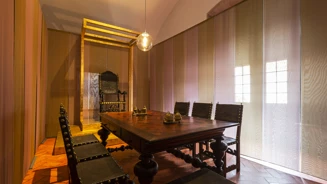House of the Council of State discovered in the National Palace of Sintra
10 Dec 2022
After three years of research, the team at the National Palace of Sintra has solved a 200-year-old riddle and identified the House of the Council of State, a space hitherto unknown by historiographers, and which will be open for visitors from 10 December. The research has led to the conclusion that the room where the 17th-century State Bed has been on display since 2019 was used, between the 16th and 18th centuries, for the highest institutions of the monarchy. Together with the adjoining room, known as the Arab Room, it housed the highest courts of the kingdom, namely the House of Appeal, and the space was later adapted for the meetings of the Council of State.
This discovery represents a new contribution to interpretation of the palace, demonstrating that, between the late Middle Ages and throughout the modern era (13th to 18th centuries), a palace was much more than a residence for the Royal Family; rather, it was a place where the king provided protection for his subjects, giving them shelter, food and justice. This triple function required three distinct spaces: reception rooms; kitchens to make food; and rooms for the judging of crimes or conflicts. When the king was in the palace, it was there that the main institutions of the kingdom were housed, making it imperative that there were rooms for the functioning of the higher courts. The identification of the rooms that had judicial functions in the National Palace of Sintra makes it the only palace in the country where it is possible to have simultaneous contact with the three aforementioned elements.
It is thought that the two rooms in question were first intended for the kingdom's highest court, the House of Appeal, which was itinerant until the 16th century. Because they frequently accompanied the king, these judges were also influential as advisers. Their importance continued to grow and, between 1562 and 1569, a Council of State was formally created as an autonomous institution that sought to ensure good governance of the kingdom. From the time when the House of Appeal was established more permanently in Lisbon, these two rooms of the palace were adapted for meetings of the Council of State, which acquired a particularly important role during the wars of restoration of independence in the 17th century.
These conclusions are the result of a complex and careful research project carried out as part of the overall project to revise the museography of the National Palace of Sintra, which involved the interconnection of extremely diverse historical sources, including an architectural analysis of the building; examination of regulations from the 15th, 16th and 17th centuries, which established the functioning of the highest bodies of the kingdom; a study of the iconography of the time; and a comparative analysis with other European palaces. Among all the documents studied, the most relevant was found in the archive of the National Palace of Sintra, a manuscript from the late 17th century entitled "Livro das (...) Cousas Ocultas" (Book of (...) Hidden Things), which, ironically, became the main source to bring this forgotten space to light.
A discovery giving rise to a bold new museum project
The identification of the original functions of these two rooms led to a new museographical project. Given the absence of objects that would enable a historical reconstruction, a bold contemporary interpretation of what these meeting spaces were was developed, valuing sensory experiences over the physical reconstruction of material elements. Instead of producing replicas of lost objects, the aim was rather to bring the experience of today's visitor closer to that of the palace's users in the past.
The first room, known as the "Arab Room", with its central fountain and geometric tiles from the time of King Manuel I, is now presented as an antechamber with the function of a waiting room. This room is also known as the "lost steps", where attorneys of the parties involved in cases being considered by the judges of the House of Appeal or messengers bearing petitions submitted to the Council of State waited.
It is in the second room, however, which was used as a meeting room for the judges of the House of Appeals and, later, for the king's councillors, that visitors will be surprised by the sensory impact of the new museography featuring textile scenography, characterised by dynamic effects that change as one moves around the space. This solution references the strong presence of textile patterns in the European Renaissance and Baroque, when lustrous silk fibres and gold and silver applications created a brilliant, heterogeneous and stimulating visual effect for the senses. Such elements created ephemeral environments of great sumptuousness and scenic power. This allegorical reconstruction intends to produce a sensory experience analogous to that of entering a room prepared for the Council of State.
The 17th-century State Bed that was in this room has since been moved to a small room next to the Room of King Afonso VI, where it will complement the narrative of the monarch's life in the Palace of Sintra. It is thought that, after his death, his body was veiled in the Magpie Room on a bed similar in appearance to this one.
Designed by the company Wello, the new display reflects a new way of approaching museographic work in palaces, emphasising the reconstitution of sensations rather than the production of material replicas. A creative solution that aligns the National Palace of Sintra with contemporary thinking (especially in terms of Sensory Studies) and encourages reflection on what the interpretation and mediation of palaces and heritage sites should be today.

